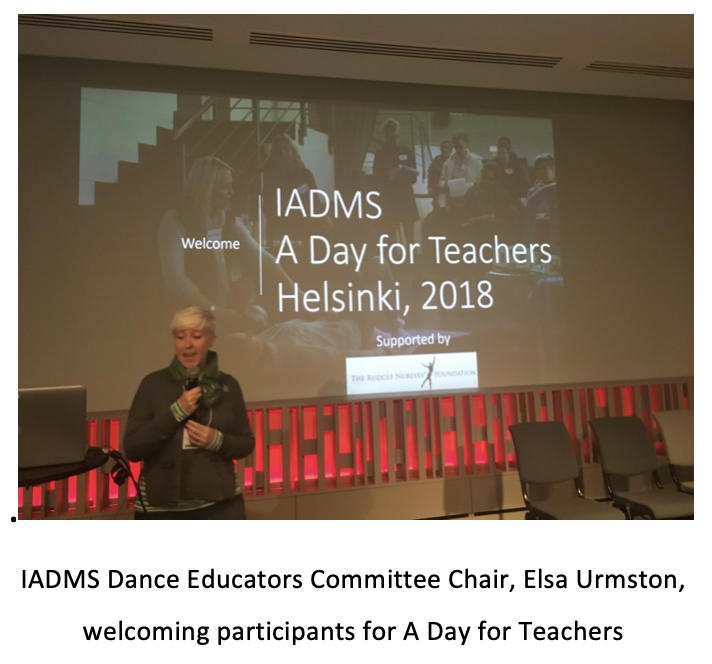Blog
Reopening dance studios in a global pandemic
Authors: Karen Sudds and Charmaine Tay on behalf of the Dance Educators' Committee
As dance studios begin to re-open, IADMS members from across the world talk about their experiences of reopening studios amongst a global pandemic, the measures they have put in place, the challenges they have faced, and the dancers’ reactions to returning.
Read ArticleInterview with 2019 Dance Educator Awardee – Nico Kolokythas
Dr Nico Kolokythas, Performance Enhancement Coach at Elmhurst Ballet School, was the 2019 recipient of the Dance Educator Award. Here Nico talks about the challenges and successes of implementing strength and conditioning training within a vocational dance school.
Read ArticleIADMS 2018: A Dance Teacher’s Perspective
Author: Fiona Wallis on behalf of the IADMS Dance Educators' Committee
I’ve been teaching ballet for over twenty years (the last twelve in Higher Education) and have been aware of IADMS for some time. 2018, however, was the year that I decided to make direct contact with this organisation and began to consider how dance science might enhance my studio-based practice. As a new member of IADMS, I was encouraged by Dance Science colleagues at The University of Chichester to attend the 2018 Helsinki conference.
Read Article2018 Dance Educator Award Winner - Stevie Oakes
Congratulations to our Dance Educator Award winner - Stevie Oakes! While she couldn't join us in Helsinki this year, check out this awesome video taken by her students of her being presented the award!
Read ArticleIADMS 2018 Helsinki: Interview with 'A Day For Teachers' Speaker - Martin Puttke
The explosive development of virtuosity and technique in contemporary dance/ballet frequently encounters not only the dancer’s physical limitation but also, and most importantly, the limitations of conventional teaching methods. Occasionally choreographers forget that performers have to incorporate their creations, which very often means that the latter have to hurl defiance at their physical boundaries - resulting in health problems or even hindering their artistic performance. In this presentation I will show the basic concept of my innovative teaching and working method in classical ballet.
Read ArticleIADMS 2018 Helsinki: Interview with 'A Day For Teachers' Speaker - Jarmo Ahonen
In dance and sports many teachers and coaches are demanding the same performances of all students. However, most people are a little bit different than the next one. Thus they should be trained more individually according their body types and especially according how they vary in bodies. The presentation gives some insight on these differences and how they could be trained safely.
Read ArticleIADMS 2018 Helsinki: Interview with 'A Day For Teachers' Speaker - Katy Chambers
This session will be focussed on neuromuscular activation patterns…basically what that means is that we will be exploring movement from the perspective of identifying ‘cheat patterns’ and trying out some techniques for undoing these. I think this is exciting and relevant as dancers often hold tension in unwanted areas e.g. neck and shoulders and this can be really challenging to correct just through instruction/cueing alone.
Read ArticleIADMS 2018 Helsinki: Interview with 'A Day For Teachers' Speaker - Paula Baird-Colt and Jane Paris
Our presentation theme for the 2018 IADMS conference is to discuss our experiences in working with elite movers, dancers and athletes. We will discuss our combined insights into different training approaches that can be used to enhance movement learning skills. We hope to encourage practitioners in the field of dance to explore the educational tools that they can employ in both elite sport and dance and the research opportunities this may create.
Read ArticleIADMS 2018 Helsinki: Interview with 'A Day For Teachers' Speaker - Nico Kolokythas
...11+ Dance is a protocol with specified progressions and regressions of the exercises depending on the abilities of the dancers, therefore can be replicated. The results indicate some physiological responses and there is also an indication of a decrease in the injury incidence. 11+ Dance, however, needs to be investigated further as the picture is not complete yet. We need longitudinal studies in order to be able to assess the effectiveness of the intervention.
Read ArticleIADMS 2018 Helsinki: Interview with Invited Speaker - Fay Nenander
Within the framework of the ‘Macro-perspectives on dance teaching’ my theme – the importance of mental training and life-style skills – will hopefully help to illuminate the significance of giving the student dancer the necessary skills for acquisition of the “mind-set” needed by a successful professional dancer. This includes both mental training and life-style skills. However, I shall emphasize that this is not just important for the student dancer, but for all dancers.
Read Article- IADMS 34th Annual Conference - Experience Point of View: Jennifer Milner
- IADMS 34th Annual Conference - Experience Point of View: Joanna Nicholas
- IADMS 34th Annual Conference - Experience Point of View: Erika Mayall
- Beginning ASL for Medical Students & Health Practitioners
- Relative Energy Deficiency in Dance









 BACK
BACK